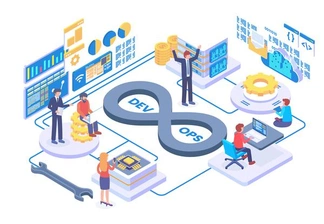As the scale of organizations increases, the structure of IT infrastructure also starts to become more complex. IT teams often find it challenging to keep pace with these increasing complexities. Applying automation simplifies operations at scale, giving you greater control over your infrastructure.
Automated Infrastructure Management has become a necessity for every organization. DevOps, a combination of software development(Dev) and operations(Ops) is the union of people, process, and technology to continually provide value to customers. It depends on an automated infrastructure setup and configurations to make quick deliveries across platforms. By adopting a DevOps culture, practices, and tools, teams build better products faster and enhance customer satisfaction.
Introduction to Infrastructure Automation
Infrastructure Automation is the process of reducing manual work with IT systems by creating scripts or functions that are multi-functional and can be used either by other software or on command. It enables developers or the operations team to automatically manage, monitor, and facilitate resources instead of manually configuring hardware, software, or operating systems. The process is also called configuration management or scripted infrastructure because the infrastructure configuration is defined in scripts.
Infrastructure Automation in DevOps

Automation is crucial for DevOps practices, and automating everything is the fundamental principle of DevOps. It starts from the developer’s machine where codes are generated and pushed to monitor the systems and applications in production.
Automation in DevOps increases the speed, accuracy, reliability, consistency and the number of deliveries. It does everything from building and deploying, to monitoring. Operations and Development play a crucial role in delivering applications.
Operations consist of all the administrative processes, support and service for the software. Development and operations collaborate in the DevOps architecture to mend the gap between the operations and deployment teams, ensuring faster deliveries. This architecture is used for widely distributed applications and for applications that are hosted on cloud platforms. When teams work separately from each other the process of designing, testing and deploying becomes more time consuming. DevOps also makes it easy to detect defects in code by promoting frequent code versions. This allows the teams to avoid app failures and defects. In case a failure occurs, both the operations and development teams share ideas and reduce the recovery time. DevOps enables better coordination and teamwork between teams to increase productivity and reduce their shortcomings.
Challenges of Infrastructure Automation in DevOps

As more and more companies start adopting DevOps, they have also started facing more challenges. Introducing the latest technology for smoother functioning and higher productivity is not necessarily leading to better performance. On the other hand, it is slowing down the entire process as the new technology needs to be understood, configured and optimized. These are some of the major challenges companies face while adopting DevOps architecture:
Culture
Every organization needs a culture of innovation, learning and disruption. Not having the right mindset among employees can lead to the failure of projects. The process of optimizing infrastructures can slow down the development and operation processes. Adapting to new and advanced technology is a task too, especially for employees who aren’t from a technical background. However, with the right culture an organization can resolve any skill and infrastructure issue.
Communication and processes
DevOps is about different departments working alongside each other at the same time. It is very important for an organization to keep all team members on the same page. Provisioning resources takes longer with outdated communications and manually built test processes. This weakens the quality of testing and development.
Infrastructure
Automation is the key to DevOps. An outdated infrastructure with no self-service and little to no automation can never be efficient. Infrastructure Automation needs constant improvements and upgrades to avoid challenges of any kind. A good automation strategy takes shape:
-
When a company is equally reliable between real and pre-production environments
-
When they have the ability to quickly access their process
-
When they are resilient to failure
Tools and Apps
Making changes to an application has become complex and time consuming. The gap between the business users and developers is something that needs to be reduced. Users don’t understand the complexity of back-end integration and believe that one app can solve all of their problems. On the other hand, developers don't have a systematic view of the business and fail to understand why a quick fix tool won't work. Using unauthorized tools by both developers and users makes the process even more complex. However, with automation in DevOps an organization can make these changes a lot faster.
Budgeting
Capital and operational expenses are interconnected. Companies begin to scale up their DevOps infrastructure through quick automation, and in doing so create another functional team. This adds to the existing infrastructure and is not quite budget friendly. They would much rather adopt cloud infrastructure to scale up their operations.
DevOps Best Practices

When a new architecture is introduced, the organization needs to implement the right strategies. Here are some best practices they can adopt to take maximum advantage of DevOps :
Quality Leadership
Having a good leader can encourage people and inspire them to be a part of the team, intellectually stimulate the team, demonstrate support and promote personal recognition by acknowledging improvements in the quality of work. A leader also demonstrates a long-term vision for team and organizational direction.
Design-for-DevOps Practices
Products and applications are architected as modules, where products can be built, tested and released separately. Applications are immutable microservices ready for deployment in cloud infrastructure. Software code changes are pre-checked using dynamic analysis tests, static analysis tools and peer code reviews. Automated test cases and code changes are checked into the integration branch at the same time, together with evidence that the tests were passed in a pre-flight test environment. Developers change their code at least once a day.
Collaborative Culture Practices
The DevOps system is built by a team of experts and is reviewed by a group of stakeholders. The system changes gradually, to ensure that the changes do not disturb current operations. The DevOps culture promotes learning from failures, cross functional collaboration, cooperation between departments and sharing of responsibilities.
Continuous Integration Practices
A software version management system is used to manage all versions of code image changes, source code changes, tools and infrastructure configuration. The system is built in such a way that there are enough resources to execute a build. The software build process is fully automated and produces artifacts, once triggered .Resources are available on-demand and will never block a build.
Continuous Integration (CI) builds scale up and down according to the complexity of changes and can complete incremental builds in an hour.
Continuous Testing Practices
Development changes are pre-flight tested in a clone of the production environment before being integrated into the trunk branch. Tests are selected and scaled automatically according to specific software changes, and a standard test script is used to guide the creation of test scripts. Release regression tests and release performance tests are automated to ensure that unacceptable degradations are not released. The test collection for each step includes a predefined set of tests selected automatically based on predefined criteria.
Elastic Infrastructure Practices
The data and files needed for creating and testing builds are automatically archived and can be recovered on demand. System configuration management and system inventory are stored and maintained in a Configuration Management Database (CMDB). Infrastructure changes are automated and managed using configuration management tools. Disaster recovery processes are automated and infrastructure failure modes are frequently tested.
Continuous Monitoring Practices
Proactive alert systems and logging make it easy to detect failures and resolve them. Key Performance Indicators (KPIs), metrics and thresholds, snapshot and trend results of each metric are automatically calculated in process and made visible to anyone on the team. Descriptive build and test analytics drive process improvements while predictive analytics are used to dynamically adjust DevOps pipeline configurations.
Continuous Security Practices
Source code for Key Intellectual Property (KIP) on build or test machines are only accessible by trusted users with verified credentials. Developers are trained to take personal responsibility for security. To ensure production systems are locked down, immutable infrastructure mindsets are adopted. Security tools are integrated into the CI/CD pipeline and security controls are automated.
Continuous Delivery Practices
Delivery and deployment stages are separate. Deliverables from the delivery pipeline are automatically pushed to the deployment pipeline, once the delivery measures are found to be acceptable. All deliverables that clear the metrics for delivery are packaged and used for deployment using containers. Deployment decisions are very lengthy and are determined according to preset metrics. In case of a deployment fail the systems are arranged with automated recovery and self-healing capabilities.
Mastering DevOps practices is an ongoing journey. For a company to flourish, the networking between employees needs to be flawless. Teams of developers and operators are accountable for different processes, and the functioning of a company only gets better as they work together.
Get in touch with us to modernize your Infrastructure and DevOps practices.






















